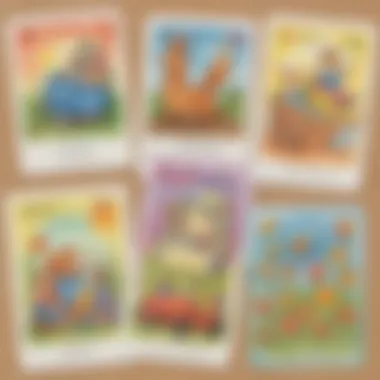Engaging Activities for Pre-K: Enhancing Early Learners with Rhymes


Creative Activities
Craft Ideas: Pre-kindergarten is the ideal time to engage children in hands-on activities that enhance their learning experience. Crafting rhyming objects such as a 'mouse in the house' or 'star in a jar' can spark creativity and reinforce rhyming skills in a tactile way. These activities not only boost language development but also improve fine motor skills as children cut, color, and paste their creations with guided adult supervision.
Step-by-Step Guides: Detailed instructions for each rhyming craft provide a structured approach for parents and caregivers. Start by gathering materials like construction paper, markers, and glue. Then, walk through each step slowly, ensuring the child understands the rhyme being illustrated with the craft. This sequential process fosters comprehension and attention to detail in the young learners.
Educational Value: Engaging in these craft activities offers a multi-faceted learning experience. From enhancing phonemic awareness by exploring rhyming words to promoting creativity through crafting, children benefit cognitively and emotionally. The educational value lies not only in mastering rhyming concepts but also in fostering a sense of accomplishment and self-expression in young minds.
Fun Quizzes
Quiz Topics: The quizzes available on Elem Fun cover a wide array of rhyming topics, ranging from simple word pairs like 'cat' and 'bat' to more complex rhyming patterns like AABB or ABAB. These diverse topics cater to different levels of rhyming proficiency, ensuring that children are both challenged and supported in their learning journey.
Question Types: Elem Fun utilizes various question types to keep children engaged and entertained while reinforcing their rhyming skills. Multiple choice questions, fill-in-the-blank exercises, and matching activities prompt kids to actively participate and interact with rhyming concepts. This interactive approach enhances retention and deepens understanding.
Knowledge Reinforcement: Through its quizzes, Elem Fun aims to solidify children's grasp of rhyming concepts by providing instant feedback and correction. By offering explanations for correct and incorrect answers, the quizzes not only test comprehension but also serve as valuable learning tools. This reinforcement mechanism boosts confidence and motivates children to continue exploring the world of rhymes.
Fact-Based Articles
Topics: The fact-based articles accompanying the rhyming activities span a spectrum of engaging themes, from the history of nursery rhymes to the science behind rhyming patterns. These diverse topics not only enrich children's knowledge of language and literature but also stimulate their curiosity and critical thinking skills.
Engaging Content: Written in an accessible and engaging manner, these articles present rhyming information in a clear and digestible format suitable for young learners. By incorporating visuals, interactive elements, and relatable examples, the content grabs children's attention and immerses them in the world of rhymes.
Additional Resources: To further support children's exploration of rhyming concepts, supplementary resources such as related articles, videos, and online games are recommended. These resources extend the learning beyond the confines of the article, encouraging continued discovery and understanding in a digital age.
Introduction
In the realm of early childhood education, the significance of incorporating engaging pre-kindergarten (pre-K) rhyming activities for young learners cannot be overstated. These activities play a pivotal role in laying a robust foundation for language development, fostering creativity, enhancing phonemic awareness, and boosting cognitive skills. As cognitive research continues to underscore the essentiality of varied stimuli for young minds, rhyming emerges as a dynamic tool that not only educates but also entertains. This article will delve into a plethora of interactive and educational rhyming activities crafted explicitly for pre-K children, aiming to kindle their linguistic curiosity and cognitive growth from the very outset.
Understanding Rhyming in Early Education
Significance of Rhyming in Pre-K Learning
Delving into the realm of early learning, the significance of rhyming in the pre-kindergarten phase proves to be a linchpin in nurturing a child's language acumen and cognitive agility. Rhyming inherently serves as a potent vehicle for memory retention, enabling young learners to grasp language patterns effortlessly. Through the melodic repetition found in rhymes, children not only absorb vocabulary but also internalize the rhythm of language, paving the way for improved articulation and communication skills. The immersive nature of rhyming activities also stimulates creativity and imagination, offering a multisensory experience that caters to various learning styles. Overall, the significance of rhyming in pre-K learning lies not only in its educational prowess but also in its ability to spark a lifelong love affair with language.
Benefits of Incorporating Rhyming Activities
The benefits accrued from integrating rhyming activities into the pre-K curriculum are manifold and profound. These activities serve as powerful tools for enhancing phonemic awareness, a crucial precursor to proficient reading and language acquisition. By engaging in rhyming exercises, children sharpen their auditory discrimination skills, differentiate between sounds, and develop a nuanced understanding of word structures. Additionally, rhyming activities foster a sense of playfulness and joy in learning, making the educational process enjoyable and engaging for young learners. Furthermore, the cognitive benefits extend beyond language proficiency, encompassing improved memory retention, cognitive flexibility, and creative thinking, all of which are crucial for holistic development at a tender age.


Target Audience
Age Group Considerations
When contemplating rhyming activities for pre-K learners, age group considerations play a pivotal role in tailoring educational content to meet developmental milestones effectively. The early years of childhood are characterized by significant cognitive and linguistic growth, making it imperative to align rhyming activities with the cognitive abilities and attention span of young learners. Engaging rhymes that are age-appropriate stimulate intellectual curiosity, language acquisition, and social interaction, laying the groundwork for future academic success. As educators and caregivers select rhyming materials, it is essential to consider the age-related nuances in language comprehension, motor skills, and attention span to create an enriching and developmentally appropriate learning environment.
Educational Objectives
Amidst the myriad rhyming activities available for early learners, delineating clear educational objectives is paramount to ensure targeted and purposeful engagement. Educational objectives serve as guiding beacons, outlining the specific skills and knowledge that children are expected to acquire through rhyming activities. By setting educational objectives, educators and caregivers can scaffold learning experiences, nurture critical thinking skills, expand vocabulary, and cultivate a deep appreciation for the beauty of language. Moreover, educational objectives underscore the importance of intentional teaching practices that promote holistic development, socio-emotional growth, and linguistic proficiency in pre-K children, laying the groundwork for a lifetime of learning and exploration.
Interactive Rhyming Games
Interactive Rhyming Games play a pivotal role in the holistic development of early learners by enhancing phonemic awareness and cognitive skills through engaging activities. These games serve as a creative and interactive way to introduce young children to the concept of rhyming, fostering a love for language from a tender age. By actively participating in these games, children not only refine their vocabulary but also improve their cognitive abilities, setting a strong foundation for future learning endeavors.
Rhyme Time Bingo
How to Play
How to Play Rhyme Time Bingo is a vital component of Interactive Rhyming Games. This game involves matching rhyming words on bingo cards, encouraging children to identify and comprehend rhymes. Through this interactive gameplay, children enhance their phonemic awareness and vocabulary while developing critical thinking skills. The simplicity and effectiveness of this activity make it a popular choice for educators and parents looking to engage pre-k learners in a fun and educational way. Its ability to promote language skills in a playful manner makes it a valuable resource for teaching early learners the intricacies of rhyming.
Learning Outcomes
Discussing the Learning Outcomes of Rhyme Time Bingo sheds light on the educational benefits it offers within the context of Interactive Rhyming Games. By participating in this game, children not only sharpen their rhyming skills but also improve their ability to recognize patterns and relationships between words. The cognitive benefits of Rhyme Time Bingo extend beyond language development, fostering critical thinking and problem-solving capabilities in young learners. The engagement and sense of achievement that children derive from successfully identifying rhymes contribute to their overall learning experience, making it a meaningful and rewarding activity.
Rhyme Match-Up
Game Instructions
Game Instructions for Rhyme Match-Up outline the process of matching rhyming pairs, stimulating children's ability to identify similar sounds within words. This activity facilitates experiential learning, as children actively participate in recognizing and differentiating between rhyming words. The clear instructions and simple gameplay of this activity make it an accessible and engaging option for early learners, promoting active involvement and interaction. By guiding children through the steps of matching rhymes, educators provide a structured environment for language exploration and skill development.
Cognitive Development Benefits
The Cognitive Development Benefits of Rhyme Match-Up highlight the positive impact of this activity on children's cognitive skills. This game not only enhances phonemic awareness but also promotes memory retention and attention to detail. Through the cognitive challenges presented in matching rhymes, children exercise their brains and cultivate essential cognitive abilities. The hands-on approach to learning offered by Rhyme Match-Up encourages children to think critically and analytically, instilling key cognitive skills that are crucial for academic success and intellectual growth.
Rhyme Relay Race
Setup and Rules


The Setup and Rules of Rhyme Relay Race set the stage for a dynamic and collaborative learning experience. This game involves a relay-style race where teams compete to relay rhyming words accurately and swiftly. By establishing clear rules and creating a structured environment, educators encourage teamwork and healthy competition among children. The setup of this activity enhances coordination, communication, and problem-solving skills, fostering a sense of camaraderie and shared achievement among participants.
Teamwork Enhancement
Teamwork Enhancement in Rhyme Relay Race emphasizes the significance of collaborative effort and communication in achieving common goals. This game not only promotes social development but also cultivates important life skills such as teamwork, leadership, and mutual respect. Through engaging in this activity, children learn to work together, communicate effectively, and support one another, thereby fostering a positive and inclusive learning environment. The emphasis on teamwork in Rhyme Relay Race not only enhances the overall gameplay experience but also instills valuable interpersonal skills that are essential for future success.
Creative Rhyme Explorations
Rhyming serves as a pivotal tool in enhancing early literacy skills in pre-kindergarten children. Creative Rhyme Explorations provide a hands-on approach to learning through artistic expression and storytelling. By engaging in activities like Rhyme Collage Art, Rhyme Time Storytelling, and Rhyme Scheme Drawing, children not only develop their phonemic awareness but also nurture their imaginative and cognitive abilities. These explorations foster a creative environment that encourages young learners to explore the nuances of language and storytelling.
Rhyme Collage Art
Art Supplies Needed
The choice of art supplies for Rhyme Collage Art plays a crucial role in stimulating a child's visual and tactile senses. Utilizing colorful construction paper, child-safe scissors, glue sticks, and markers enhances the creative experience. These supplies not only facilitate the creation process but also allow children to visually represent the rhyming words they are learning. The tactile nature of the materials promotes sensory engagement, making the learning process more interactive and memorable.
Engagement with Rhyming Words
Engagement with Rhyming Words during Rhyme Collage Art sessions strengthens the connection between imagery and language. As children select rhyming words to incorporate into their collages, they develop a deeper understanding of phonetic patterns and word associations. This hands-on approach to exploring rhymes fosters creativity and linguistic dexterity. By actively engaging with rhyming words in a visual form, children internalize these concepts more effectively, paving the way for enhanced language skills.
Rhyme Time Storytelling
Narrative Development
Narrative Development through Rhyme Time Storytelling nurtures children's storytelling abilities and sequential thinking. Encouraging children to create narratives using rhyming words helps them structure cohesive stories with a clear beginning, middle, and end. This process of organizing thoughts and ideas enhances cognitive development and communication skills. Through storytelling, children learn to craft coherent narratives, enhancing their ability to express ideas and emotions effectively.
Imaginative Expression
Imaginative Expression through Rhyme Time Storytelling allows children to unleash their creativity and explore divergent thinking. By weaving rhyming words into imaginative tales, children expand their vocabulary and narrative repertoire. This creative outlet not only cultivates a love for storytelling but also fosters imaginative thinking and problem-solving skills. Engaging in imaginative expression through rhymes empowers children to think outside the box and envision new possibilities, enriching their overall cognitive development.
Rhyme Scheme Drawing
Artistic Skills Enhancement
Rhyme adorns drawing activities emphasize artistic skills and visual literacy among pre-kindergarten children. By incorporating rhyming words into drawings, children develop fine motor skills, hand-eye coordination, and creative expression. This multisensory approach to art fosters children's artistic confidence and style, allowing them to express themselves through colorful and meaningful illustrations. Artistic Skills Enhancement through rhyme scheme drawing nurtures a child's aesthetic sensibilities and appreciation for imaginative expression.
Connection to Literacy


The Connection to Literacy in rhyme scheme drawing activities bridges art and language, promoting a holistic approach to early education. By associating rhymes with visual representations, children deepen their understanding of storytelling and linguistic concepts. Drawing prompts that utilize rhyming words encourage children to make visual connections to the words they are learning, reinforcing their comprehension and retention. This cross-disciplinary integration of art and literacy enriches children's cognitive skills, fostering a well-rounded educational experience that transcends traditional boundaries.
Incorporating Rhymes into Daily Routine
Rhyme of the Day Circle Time
Morning Circle Activity:
At the core of the rhyme of the day circle time is the morning circle activity, a key element in structuring a pre-kindergarten's learning experience. This activity serves as a dynamic platform for introducing new rhymes, enhancing vocabulary, and setting a positive tone for the day ahead. The morning circle activity provides children with a structured and interactive environment where they can actively participate in reciting rhymes, identifying rhyming words, and engaging in language-based exercises. Its emphasis on group participation and oral language skills nurtures social interaction, cognitive development, and a sense of community among young learners. Through the morning circle activity, children not only develop their phonemic awareness and linguistic abilities but also cultivate a sense of belonging and collaboration within the classroom setting.
Interactive Learning Moments:
Incorporating interactive learning moments into the rhyme of the day circle time enriches the overall educational experience for pre-kindergarten children. These moments encompass a diverse range of activities that encourage hands-on exploration, critical thinking, and creativity. By infusing play-based learning techniques within the circle time structure, interactive learning moments spark children's curiosity, imagination, and cognitive engagement. Whether through rhyming games, tactile exercises, or multimedia tools, these interactive sessions offer a multi-sensory approach to language acquisition and skill development. By leveraging interactive learning moments during the rhyme of the day circle time, educators can nurture a holistic learning environment that caters to the diverse needs and learning styles of young learners, ultimately fostering a deep and enduring appreciation for language and literacy.
Rhyme Snack Break
Healthy Snack Ideas:
A crucial component of incorporating rhymes into the daily routine involves enhancing the snack break experience with healthy snack ideas. By introducing nutritious and visually appealing snacks inspired by rhyming themes, educators can create an immersive and educational environment for pre-kindergarten children. Healthy snack ideas not only promote physical well-being and proper nutrition but also serve as an opportunity to reinforce rhyming concepts in a practical and engaging manner. From alphabet-shaped fruits to thematic snacks based on popular rhymes, these creative food options encourage children to associate language with everyday experiences, creating memorable and enriching connections between words and actions. By aligning nutritious snacks with rhyming activities, educators can instill healthy eating habits while fostering a positive relationship between language learning and sensory experiences.
Vocabulary Building:
Another key aspect of the rhyme snack break revolves around vocabulary building as an essential component of early language development. Through intentional and interactive vocabulary-building exercises during snack time, pre-kindergarten children can expand their word bank, improve their communication skills, and enhance their overall language proficiency. By incorporating themed vocabulary games, word associations, and storytelling prompts, educators can stimulate children's linguistic abilities, foster a deeper understanding of rhyming patterns, and promote a rich and varied vocabulary repertoire. The synergy between snack breaks and vocabulary building creates a linguistically immersive environment where children can actively engage with language in a meaningful and enjoyable way, paving the way for robust language skills and cognitive growth.
Bedtime Rhyme Ritual
Calming Bedtime Routine:
The bedtime rhyme ritual serves as a soothing conclusion to the day's activities, offering pre-kindergarten children a calming and comforting transition to bedtime. By incorporating rhythmic and melodic rhymes into the bedtime routine, educators can create a relaxing atmosphere that promotes emotional well-being, language enrichment, and literacy development. The calming bedtime routine includes gentle rhymes, lullabies, and storytelling sessions that help children unwind, relax, and embrace the quietude of nightfall. This structured and repetitive ritual not only signals the end of the day but also reinforces language skills, boosts memory retention, and cultivates a bedtime routine that prioritizes language enrichment and emotional reassurance.
Language Enrichment:
At the heart of the bedtime rhyme ritual lies language enrichment as a fundamental goal in nurturing early literacy skills. By infusing bedtime routines with rhyming activities, educators can scaffold children's language development, stimulate their cognitive processes, and enhance their expressive language abilities. Language enrichment during the bedtime ritual entails using rhymes, stories, and verbal interactions to create an immersive and language-rich environment that supports children's language acquisition and literacy comprehension. Through consistent exposure to rhyming words, rhythmic patterns, and storytelling elements, children not only expand their vocabulary but also develop a deep appreciation for language as a storytelling tool, fostering creativity, imagination, and a lifelong love for narratives and words.
Conclusion
Enhancing Early Learning Through Rhyming
Summarization of Key Benefits
In understanding the summarization of key benefits associated with incorporating rhyming activities, it becomes evident that such engagement fosters a multi-faceted development in early learners. By participating in rhyme-based games and creative exercises, children not only enhance their phonemic awareness and vocabulary but also improve their cognitive abilities. This comprehensive approach to learning not only makes education enjoyable but also contributes significantly to their overall academic progress. The unique feature of this approach lies in its ability to seamlessly combine fun and education, ensuring that children actively engage with learning concepts while enjoying the process. Ultimately, the summarization of key benefits emphasizes the importance of integrating interactive rhyming activities into early education for holistic development.
Long-Term Educational Impact
Examining the long-term educational impact of rhyming activities unveils a sustained benefit that extends far beyond the early years. By instilling a love for language and learning at a young age, children are well-equipped to navigate complex literacy tasks and academic challenges as they progress through school. The key characteristic of this long-term impact is the solid foundation it creates for advanced language skills and cognitive functions. Additionally, the seamless integration of rhyming into daily routines ensures that children develop a lasting affinity for language, setting the stage for a lifelong journey of learning and growth. While there may be challenges in maintaining this educational approach consistently, the long-term benefits far outweigh any initial hurdles, making it a commendable choice for educators and parents invested in the comprehensive development of young minds.







